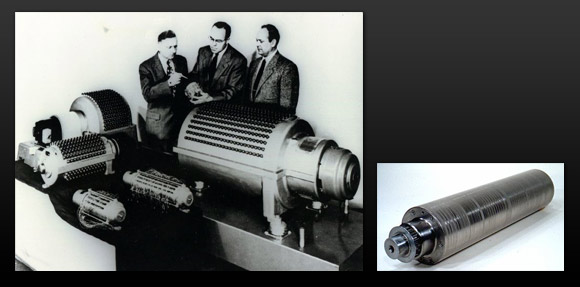Another technology that found fairly widespread use in those days was the magnetic drum. Compared to delay lines and CRTs the magnetic drum memory was large. Typical sizes were 8 to 64 kilobytes early on and expanded later. Drums were used as main memory (RAM) and as storage, like a modern hard disk drive. They were manufactured into the 1970s and used until the early 1980s. They fell out of favor in the late 1950s and early 1960s as RAM when magnetic core memory became available. They were eventually replaced for storage by the hard disk drive.
A magnetic drum is similar in concept and operation to a modern hard disk drive (HDD.) But the HDD consists of flat disks that spin like an old vinyl record and store data on the flat surface. It normally has a single read/write head for each storage surface and the head has to move back and forth across the surface to read different tracks of data. In contrast, the magnetic drum was a single cylinder that stored data on the outside surface. It spun around the central axis and typically had a read/write head for each data track. That did away with the time needed to position the head over the needed track, but it still required time waiting on the proper data to spin around to the head. To help overcome the rotational latency waiting on the proper data to spin around, it was common to place the next instruction of a program at the data location on the drum that would be just coming available as the previous instruction completed. Some drum machines had the same number of read/write heads as the computer had bits in its instructions. With that arrangement, an entire word of memory could be read or written at once.
As an example, the drum used in the IBM 650 was 16 inches long and had 40 tracks. It could store 10 kilobytes. It spun at 12,500 RPM meaning that if you just missed the data you wanted you would have to wait 80 microseconds for that data to come back around. In these days of multi-gigahertz computers one microsecond delay is an eternity. But such were the rules of the game in those days.

Magnetic drums from (left) UNIVAC computer and (right) IBM 650.
Photo from royal.pingdom.com
Magnetic core memory became available in the 1950s and gave the drum a short life as main memory. The cheaper, faster, smaller, and larger capacity of core quickly replaced the drum in most computers. As storage memory the drum lived a while longer. But the invention of the hard disk drive with similar improvements eventually killed the drum in that role as well. Core memory would rule for about 20 years and soon we will take a look at it.
No comments:
Post a Comment